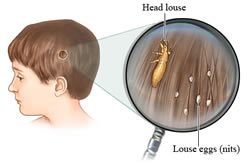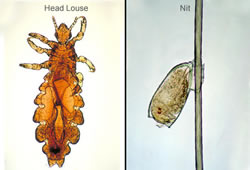Difference between Nits and Lice
Key difference: Head lice are tiny, wingless, parasitic insects that live and feed on blood from your scalp. Lice reproduce by laying eggs in the hair. These eggs are called nits. In some countries like United Kingdom, Australia and New Zealand, the term ‘nits’ may be used to refer to the lice itself. However, usually ‘nits’ refer to the eggs of the lice that have already hatched.
 Both nits and lice are a parasitic infestation that can often trouble humans: adults and children, but especially school going children. The reason for this is that children tend to provide the close head-to-head contact that is ideal for an infestation to spread. This is especially true for girls with long hair, as the loose long hair more likely come into contact with lice, especially via an infested person. However, lice may spread quickly in a family or a group of friends and playmates, mainly due to close contact.
Both nits and lice are a parasitic infestation that can often trouble humans: adults and children, but especially school going children. The reason for this is that children tend to provide the close head-to-head contact that is ideal for an infestation to spread. This is especially true for girls with long hair, as the loose long hair more likely come into contact with lice, especially via an infested person. However, lice may spread quickly in a family or a group of friends and playmates, mainly due to close contact.
Head lice are tiny, wingless, parasitic insects that live and feed on blood from your scalp. There are other types of lice, including body lice, which affects the body and pubic lice, which affects the pubic area. The head lice are the most common form of infestation that most humans face.
Head lice are a very common problem, affecting millions of people each year. They commonly affect preschool and elementary school-aged children, who unknowingly infect each other and others close to them, such as family members. However, getting a head lice infestation is not a sign of bad personal hygiene or an unclean living environment. It is an itchy infestation commonly spread through close personal contact and by sharing personal belongings, such as caps, hats and scarves, brushes and combs, hair decorations, such as barrettes, and headphones. It may even rarely spread through home furnishings, such as towels, clothing, blankets, pillows, upholstered furniture.
The louse has six legs and scuttles very fast, like a crab, as oppose to jumping. The louse had has pincers at the end of the legs, similar to crabs, which allow them to hold on the hair. Hence, lice are harder to find and dislodge from the hair.
Lice can survive on blood, dead skin particles, among other things. Lice also do not usually leave bite marks in the skin. They just cause itchiness in the scalp. Some types of lice are known to leave small, red bumps on the scalp, neck, and shoulders, which may become crusty and ooze. However, these are rare occurrence. Furthermore, lice spend their entire lives linked to human beings, usually a single human. Hence, they are not able to carry and spread diseases.

Lice reproduce by laying eggs in the hair. These eggs are called nits. In some countries like United Kingdom, Australia and New Zealand, the term ‘nits’ may be used to refer to the lice itself. However, usually ‘nits’ refer to the eggs of the lice that have already hatched.
Female head lice lay up to 3-5 eggs a day. These eggs are attached to the root of an individual hair strand by means of a special type of glue excreted by the female lice. The eggs are attached usually between 1/16 to a 1/4 inch away from the hair. This is so that when the eggs hatch, the young lice have close access to their food source, i.e. the scalp. Furthermore, in order for the eggs to hatch and survive, they need the heat from the scalp as well. Nits, i.e. hatched eggs, will be usually found more than about 1/2 inch from the scalp. Once the eggs have hatched, the nits remain glued to the hair shaft and grow out as our hair grows.
Unhatched lice eggs are light-colored when they are first laid, usually yellow-tinted or grey. Right before hatching, they turn darker shades of tan or coffee. After they hatch, the nits are white to cream in color. They look like a tiny teardrop about the size of a pin head. Due to their color and size, nits are often mistaken for dandruff.
The most common way to differentiate between dandruff and head lice is to check the scalp for louse. However, if a grown louse cannot be found, a way to ensure lack of infestation is to check after shampooing the hair thoroughly. If the white flecks have disappeared from the scalp then it is dandruff, however, in case of head lice, the white flecks will remain and so will the itchiness.
Still, the presence of nits does not ensure that there is a lice infestation. Nits are often leftover after an infestation is bested. The problem arises as nits are often the first visible sign of a head lice infestation, as lice are great at hiding and run from the light. This makes finding a louse very difficult. Furthermore, unhatched eggs are often too close to the scalp to be visible to the naked eye. Hence, the best solution is to treat nits like a lice infestation. This may help prevent a recurring infestation.
Nits, like unhatched eggs and lice, should be combed out of the hair with a special comb. They may also be treated with nonprescription shampoo that's specifically formulated to kill lice. There are also various home remedies, one could try. Furthermore, all personal belongings such as caps, hats and scarves, brushes and combs, hair decorations, and even home furnishings, such as towels, clothing, blankets, pillows should be cleaned thoroughly. As an added precaution, upholstered furniture, rugs, carpets can also be vacuumed.
Image Courtesy: uofmhealth.org, webmd.boots.com









Add new comment